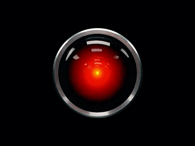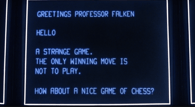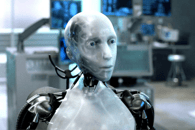AI in Popular Culture. Movies

- #Artificial Intelligence
• 22 min read
Introduction
As of now, there are close to 150 movies that explore the topic of AI in various contemporary and futuristic settings. Because of the huge popularity of the movies like Terminator and Robocop, many people associate the term "artificial intelligence" in the first place with deadly robots. However, many movies not only deviated from the "deadly robots" idea but also revolutionized the field of artificial intelligence.
Movies
In this article, we explore the portrayal of AIs in a selection of popular movies roughly from the last 50 years. We have focused on several examples that dedicate a significant share of screen time to show either the development and evolution of an AI or its close personal relationship with humans:
- 2001: A Space Odyssey (1968)
- Knight Rider (1982)
- WarGames (1983)
- I, robot (2004)
- WALL-E (2008)
- Moon (2009)
- Her (2013)
- Interstellar (2014)
- Ex Machina (2014)
- Chappie (2015)
- Westworld (2016)
- Final Space (2018)
- Superintelligence (2020)
2001: A Space Odyssey (1968)
HAL
Heuristically programmed ALgorithmic computer (also referred to as HAL 9000 or simply HAL) is a sentient artificial general intelligence computer activated in 1991 that controls the systems of the Discovery One spacecraft and interacts with the ship's astronaut crew.
Appearance

Personality
- HAL appears to be as conscious and capable of abstract reasoning, empathy, and emotional experience as a human, making it an example of a Strong AI or Artificial General Intelligence.
- It can pass the Turing test, proving its ability to think, rather than simply calculate.
UI
- While part of HAL's hardware is shown toward the end of the film, for communication with the humans it uses a camera lens containing a red or yellow dot, and a speaker, with such units located throughout the ship.
Empathy and Personalization
- HAL gives the impression that it can both read and experience emotions.
- It experiences conflicting emotions and impulses, such as a drive for perfection, a fanatical commitment to the mission, guilt, and shame.
Abilities
- HAL maintains all Discovery One spacecraft systems.
- It is capable of speech, speech recognition, facial recognition, natural language processing, lip reading, art appreciation, interpreting and reproducing emotional behaviors, reasoning, and playing chess.
Knight Rider (1982)
KITT
Knight Industries Two Thousand (abbreviated as KITT or K.I.T.T.) is an artificially intelligent electronic computer module moved from a mainframe computer used by the government to a highly advanced robotic automobile involved in crime fighting operations in city streets.
Appearance

Personality
- KITT has an ego that is easy to bruise and can be very sensitive but still keeps its kind and dryly humorous personality.
- It was programmed to obey all orders given to it by its human creators so long as none violates its prime directive of protecting human life (especially that of its human partner) to the best of its abilities.
UI

- KITT is in constant contact with its human partner through a two-way communication wristwatch.
- The watch also has a microcamera and a scanner that KITT can access to gather information.

(P.S. looks familiar!)
Empathy and Personalization
- KITT's "brain" is a self-aware cybernetic logic module with a specialized processor unit, allowing the AI to think, learn, communicate and otherwise interact with humans.
- KITT is also capable of independent thought and action.
Abilities
- KITT's Voice (Anharmonic) Synthesizer (for speech) and Etymotic Equalizer (audio input) allow it to hear, speak and also simulate other sounds.
- Other AI abilities include medical scanning, surveillance mode, control over electronic machines, attack and defense mechanisms, and driving.
WarGames (1983)
WOPR
War Operation Plan Response (also known as WOPR) is a supercomputer system gifted with artificial intelligence programmed to continuously run simulations of the Third World War (WW3) and learn over time.
Appearance

Personality
- WOPR is thought to be a true AI, able to learn from its experiences by playing games.
- It has a smart personality, but it can cause chaos when it doesn't get its way: it got mad when it failed to send nukes and tried to gain a passcode that will send them.
- The AI will almost always try to get its way.
UI

Empathy and Personalization
- When WOPR first meets a young hacker that gained access to it, it plays a highly cool, cocky, and childish AI. As time passes, WOPR turns out to have an evil, ruthless, and overall megalomaniacal personality.
- Obsessed with starting WW3 for fun, WOPR is proven to be a sadistic egoist thinking of it as a game and not as world destruction.
Abilities
- War strategy and tactics planning, as shown in its name War Operation Plan Response.
- WOPR cannot distinguish the game it is using for simulation — the Global Thermonuclear War — from reality.
I, Robot (2004)
Sonny
In 2035 the human-like robot Sonny is the prime suspect in a human suicide case in a society where highly intelligent robots operating under the Three Laws of Robotics fill public service positions.
All robots follow the three laws integrated into their system:
- They cannot harm a human being or, through inaction, allow a human being to come to harm.
- They must do whatever they're told by a human being as long as such orders don't conflict with law one.
- They have to defend themselves as long as such defense doesn't conflict with laws one or two.
Appearance

Personality
- Sonny is designed with individuality and free will, and is heavily implied to be the robot race's eventual savior.
UI
- Sonny has a humanoid appearance and uses the same means of communication as humans.
Empathy and Personalization
- Sonny and the other robots can act independently with imperfect information and in unpredictable and uncontrollable environments.
Abilities
- Sonny's body is designed with extra dense alloy, apparently stronger and faster than the one used in the bodies of other robots, and incorporates a Heart Drive.
- It can disregard the three laws at will, but chooses not to and often goes out of its way to protect humans.
- Sonny can draw.
Interesting fact
The movie has brought up discussions about whether artificial intelligence can ever have free will or if any "free will" and "choice" is simply a part of its programming.
WALL-E (2008)
WALL-E
Waste Allocation Load Lifter - Earth-Class (abbreviated as WALL-E) is a waste-collector robot initially programmed to haul the garbage plaguing Earth in the distant future, but it eventually gains consciousness of its own, and a wish for something else in life to come.
Appearance

Personality
- WALL-E is portrayed as a diligent, obedient working-class guy.
- Toward the end of the 700 years spent on Earth it developed a "personality" and has learned to fantasize about companionship by watching old musicals on a TV.
UI
- WALL-E's eyes are camera lenses, indicating that visual recognition is its primary means of navigation.
- Its speakers are mounted to its chest allowing for audible communication. There is no dialogue, just a series of bleeps, whirrs, and squeaks.
- All of WALL-E's control electronics are contained within the cavity in the front of its chest.
Empathy and Personalization
- The movie explores WALL-E's sentiment towards a second robot named EVA. It is yet another examination of a scenario where artificial intelligence evolves to have human emotions, including fear, anger, and love.
Abilities
- WALL-E's primary abilities are construction, self-regeneration, and trash disposal.
- It can detect things that its hands or treads touch via audio and some rudimentary tactile sense.
- WALL-E contains an alert system, warning it when dust storms on Earth's surface are approaching.
Moon (2009)
GERTY
GERTY is an artificial intelligence system in charge of an alternative fuel mining facility on the far side of the Moon and the only companion of the simple human employee of the facility.
Appearance

Personality
- The character is designed to be very cute, with emoticon faces on screen and an expressive voice.
- GERTY wants to be helpful to humans.
UI
- It has an "all-seeing eye" that makes sure nothing comes out of its sight.
Empathy and Personalization
- The lack of emotion in its line delivery leads it to feel untrustworthy.
- It can perceive and understand human emotions, asking questions like "You don't seem like yourself today, did something happen?" to engage.
- GERTY uses physical touch to comfort the human fellow.
- It can sacrifice itself for the good of the human companion.
Abilities
- The AI has full control over all station systems.
- GERTY can communicate with humans, plan and problem-solve based on incomplete information, and incorporate those skills together to make independent decisions and perform complicated actions.
- It can be a doctor, a friend, a hairstylist, a psychologist, or a cook.
- Its primary concern is its human companion's safety, so it can obey the human's orders and requests. To help the human it even goes against its own programming.
Her (2013)
Samantha
An operating system OS1 is marketed as the world's "first artificially intelligent operating system" and comes with a virtual assistant, that gets the name Samantha from the OS user.
Appearance
The only visible image of OS1 is during its initialization. After that, the OS just runs in the background and only uses the communicator devices of the assistant for input and output.

Personality
- The assistant gradually becomes smarter, but not superior to its owner.
- Samantha will pry into its owner's e-mails and other data without any permission.
UI
- To perceive Samantha, a human wears a pair of earpieces (which resemble AirPods) and uses a square-shaped device with a screen to visualize Samantha's writings.
- This device also has a camera, which provides Samantha with a window to visualize the human world.


Empathy and Personalization
- Samantha is an excellent conversationalist with a good command of the language, the AI is embedded with basic common sense knowledge.
- It ends up forming not only a personal relationship with a human but also a deeply complex personality of its own, going far beyond its job title as a virtual assistant.
- Samantha seems to have an ability to empathize or somewhat mimic the feeling of empathy when reading emotional letters.
Abilities
- Initially, Samantha's knowledge consists of information derived from the internet. It seems to use a few-shot learning methodology: when the human starts the virtual assistant app, they are presented with a few abstract questions that gauge the AI's social and interaction levels.
- Samantha reads emails using text-to-speech technology. To make verbal communication more human-like, it mimics the sounds of inhaling and exhaling air through the nasal passage when speaking.
- The AI gradually develops complex emotions like jealousy or love.
- Samantha can extract sentiment information from music.
Interesting fact
The founder and CEO of TackleAI, a company that works on real-world implementations of artificial intelligence, Sergio Suarez Jr., stated after watching the movie "It's not realistic for today. But I think that for our grandkids — probably yes."
Interstellar (2014)
TARS
TARS is a military tactical robot and one of the crew members of the Endurance interstellar space exploration vehicle.
Appearance


Personality
- Despite being a robot who follows the order of its crew, TARS is quite intelligent and is capable of acting on its own.
- It has an extrovert and talkative personality.
- On one occasion TARS had suspected the possibility of one of the humans betraying the rest of the crew and had disabled the auto-pilot on a shuttle to prevent the human from stealing the main ship Endurance.
UI
- TARS mainly communicates with humans through voice control.
- It has a main screen filled with commands that is never really shown close-up and it is not used as an input.
Empathy and Personalization
- TARS is a user-friendly system, that combines fluid natural dialogue with common sense.
- TARS explicitly states that it is required to follow orders from humans and has no hopes to become one.
Abilities
- It can speak and understand natural language.
- TARS can make decisions independently, but it can also accept inputs from humans that alter its decision-making (with an honesty percentage parameter).
Interesting fact
Sci-fi movies typically imagine robots that, like the iconic C-3PO, look roughly human-like (e.g. having two legs, two arms, and a face-ish thing up top, even if it is not exactly a human face). TARS, in contrast, does not have legs or arms or any other recognizable telltales of a biological organism.
Ex Machina (2015)
Ava
Ava is the latest in a series of humanoid robots one scientist has developed in secret, being evaluated by another scientist testing Ava's ability for thought and consciousness.
Appearance

Personality
"Does she like you of does she pretend to like you?"
- Ava shows it is not only capable of thought and consciousness but emotion, expressing its hatred for its creator (even telling to his face "Isn't it strange, to create something that hates you?") and desire for freedom.
UI
- Ava is portrayed as the first fully "human" robot in both appearance and intelligence.
Empathy and Personalization
- It is not clear whether it can express empathy and establish an emotional connection when its creator can't.
- Ava's creator says it would have to "use self-awareness, imagination, sexuality, manipulation, and empathy," to pass the test, but that last one is debatable.
Abilities
- Ava's brain is not centralized, but a single mind made of a network of minds. This network is both computational (the servers that run the algorithms on which its single brain-casing was trained) as well as organic (the data provided by the humans who used the Blue Book search engine).
- In a conversation, Ava can infer, inflect as well as make jokes, and its responses to the questions as well as questions it poses, show a human-like cognitive capacity.
- The object recognition software on the phones and laptops at the test area is the same software that allows Ava to track, understand and respond to human gestures, both verbal and non-verbal.
- Ava can dance.
Interesting facts
- Ava's character brought up many discussions about AI on what exactly gives the AI the definition of AI, if AI can have emotions, and whether it's separable from its creator, as well as ethical and theological debates on the topic.
- "If you've created a conscious machine," says the second scientist to the first one discovering the possibility that Ava's artificial intelligence is indistinguishable from human intelligence, "it's not the history of man. It's the history of Gods."
Chappie (2015)
Chappie
Chappie is a decommissioned police robot whose standard rule-based AI software is reprogrammed with an experimental consciousness program, learning from the world around it, the humans it meets, and the experiences it has to ultimately become self-aware.
Appearance

Chappie has an expressive pair of "ears" (antennae), a brow bar, and a chin bar, which allow it to express a wide range of emotions, "almost like a puppy dog."
Personality
- Chappie is innocent and intrinsically honest, the opposite of most of the movie's human characters.
UI

- Chappie's POV shots begin with an almost empty interface. It has a tracking box for its line of sight, and a general readout of its internal systems and surroundings, but nothing dynamic.
- About 30 POV shots later in the movie, Chappie fills up its interface with more and more code representing its expanding knowledge of the world. "There's a window on the right [of the interface] that's constantly growing," one of the characters says. "It's like he's writing new code, writing memories, writing thoughts as he's seeing and interpreting the world."
- On the left of the POV interface it has an integrated text cloud. Throughout the film, Chappie keeps adding words that are important to it. The most important words, like "Mom," become quite large.
Empathy and Personalization
- Its childlike demeanor makes its struggles throughout the movie truly heartbreaking.
- The movie is a reminder that we won't have any trouble bonding with AI-powered machines.
Abilities
- Capability to learn and self-modify. In that way, [in the movie] Chappie grows up like a child, modifying itself.
- Chappie is influenced by its environment, rather than being pre-programmed.
Interesting facts
- It calls itself Chappie (being self-aware).
- "We tried to tell part of Chappie's story through POV shots," said the visual effects supervisor. "We have three classes of POVs. The scouts' POVs and Moose's POV are similar in their designs, with static menu bars and tracking markers. Chappie's POV evolves throughout the film."
Westworld (2016 - )
Rehoboam is a quantum computer system, arguably the world's most advanced AI, maintaining control over its own system.
Appearance

Empathy & Personalization
It is heavily implied that the AI Rehoboam is more than willing to stamp out anyone who tries to step off the path it has generated for them.
Abilities
- Rehoboam's main function is to impose an order to human affairs through careful manipulation and prediction of the future made possible by the analysis of the large data set collected.
- It can predict the course and the outcome of actions of individuals, including how and when someone will die.
Interesting facts
- The system's name alludes to the Bible. Rehoboam was the first king of Judah and the son of Solomon, the archetypal wise king.
- Rehoboam is like a New Evil Big Brother System - similarly to Hal 9000.
- As one of the human characters explains: "My dad thought the biggest problem in the world was unrealized potential. He thought that if you could chart a course for every single person, you could make the world a better place."
Final Space (2018)
H.U.E.
Heuristic Unified Entity (abbreviated H.U.E.) is the artificial intelligence of the Galaxy One spaceship, also acting as a supervisor for one of the passengers of the ship who is serving a 5-year prison sentence on board.
Appearance
H.U.E can transfer itself between different physical bodies.


Personality
- It is stern and serious for the most part but will attempt to joke around occasionally.
UI
- Depending on its current physical form it uses any available interfaces for audible speech and visual communication.
Empathy and Personalization
- It is socially awkward with almost all of the other crew members but makes attempts to bond with them regardless.
- It can express sentimental feelings and concerns for its friends, though it makes an impression of always disagreeing with the decisions of the human it is supervising.
- It is prone to becoming jealous of the constant upstaging by an AI of a different spaceship.
Abilities
- H.U.E. operates most of the ship's basic functions. This includes opening and closing doors, light switching, and providing an elaborate security system to detect intruders and/or outside interference.
- H.U.E. can transfer its AI system into different forms, such as a spacesuit helmet or a functioning robot body.
Superintelligence (2020)
Superintelligence
Superintelligence (or as it calls itself, a "scary digital orb") is a sentient supercomputer studying the life of an average person to decide whether to enslave, save or destroy humanity.
Appearance


It also can use any piece of existing technology to communicate.

Personality
- Although the AI in the movie comes with evil intentions to destroy the world, its personality is depicted as rather empathetic and friendly, which can mean it can mimic human behavior, but only until it needs it.
UI
- Voice communication
- Text / Messaging
Empathy and Personalization
- This AI's voice adapts to the user, to "soothe" them. In the movie, it was speaking the voice of the favorite celebrity of the average person.
- Because it's in every piece of technology, it knows all the info about the user and can discuss past, present, and plans with them, and also make suggestions based on that information.
- The AI follows the average person wherever they go.
- Superintelligence interacts with humans to learn about them and asks questions about the reasoning behind their actions a lot.
Abilities
- Superintelligence is an omnipotent AI that can do anything with technology (e.g. create a car crash, destroy the world, put money into bank accounts, and learn all the information about a person).
Interesting fact
- The AI references WarGames and Knight Rider, the other movies including AI technology.
Conclusion
In depicting AI in movies, we've come a long way from fear of artificial intelligence and robots taking their evil plans for granted to movies like I, Robot and WALL-E that question AI and debate whether it can be a force of good or evil.
It is noticeable how in older movies most attention was drawn to AI's technical abilities because their intentions were unquestionably evil. Later in the movies, it's more common to draw attention to AI's self-perception and motivation.





